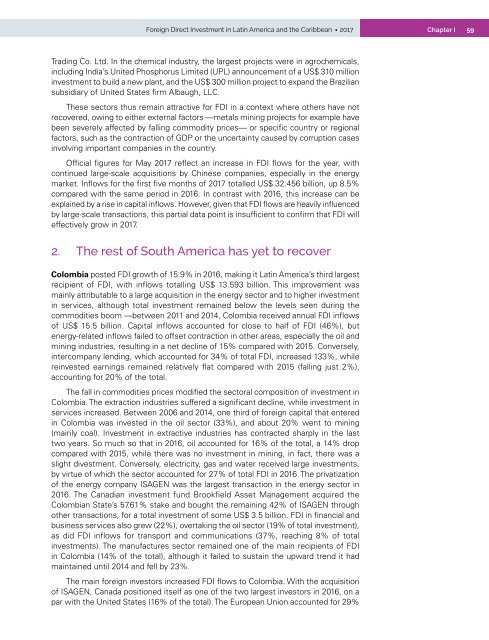Foreign Direct Investment in Latin America and the Caribbean 2017
This publication sets out and analyses the main foreign direct investment (FDI) trends in the countries of Latin America and the Caribbean. The 2017 edition shows that the region is at a difficult juncture. FDI inflows declined by 7.9% in 2016, to US$ 167.043 billion, representing a cumulative fall of 17.0% since the peak in 2011. The fall in commodity prices continues to affect investments in natural resources, sluggish economic growth in several countries has slowed the flow of market-seeking capital, and the global backdrop of technological sophistication and expansion of the digital economy has concentrated transnational investments in developed economies.
This publication sets out and analyses the main foreign direct investment (FDI) trends in the countries of Latin America and the Caribbean. The 2017 edition shows that the region is at a difficult juncture. FDI inflows declined by 7.9% in 2016, to US$ 167.043 billion, representing a cumulative fall of 17.0% since the peak in 2011. The fall in commodity prices continues to affect investments in natural resources, sluggish economic growth in several countries has slowed the flow of market-seeking capital, and the global backdrop of technological sophistication and expansion of the digital economy has concentrated transnational investments in developed economies.
You also want an ePaper? Increase the reach of your titles
YUMPU automatically turns print PDFs into web optimized ePapers that Google loves.
<strong>Foreign</strong> <strong>Direct</strong> <strong>Investment</strong> <strong>in</strong> Lat<strong>in</strong> <strong>America</strong> <strong>and</strong> <strong>the</strong> <strong>Caribbean</strong> • <strong>2017</strong><br />
Chapter I<br />
59<br />
Trad<strong>in</strong>g Co. Ltd. In <strong>the</strong> chemical <strong>in</strong>dustry, <strong>the</strong> largest projects were <strong>in</strong> agrochemicals,<br />
<strong>in</strong>clud<strong>in</strong>g India’s United Phosphorus Limited (UPL) announcement of a US$ 310 million<br />
<strong>in</strong>vestment to build a new plant, <strong>and</strong> <strong>the</strong> US$ 300 million project to exp<strong>and</strong> <strong>the</strong> Brazilian<br />
subsidiary of United States firm Albaugh, LLC.<br />
These sectors thus rema<strong>in</strong> attractive for FDI <strong>in</strong> a context where o<strong>the</strong>rs have not<br />
recovered, ow<strong>in</strong>g to ei<strong>the</strong>r external factors —metals m<strong>in</strong><strong>in</strong>g projects for example have<br />
been severely affected by fall<strong>in</strong>g commodity prices— or specific country or regional<br />
factors, such as <strong>the</strong> contraction of GDP or <strong>the</strong> uncerta<strong>in</strong>ty caused by corruption cases<br />
<strong>in</strong>volv<strong>in</strong>g important companies <strong>in</strong> <strong>the</strong> country.<br />
Official figures for May <strong>2017</strong> reflect an <strong>in</strong>crease <strong>in</strong> FDI flows for <strong>the</strong> year, with<br />
cont<strong>in</strong>ued large-scale acquisitions by Ch<strong>in</strong>ese companies, especially <strong>in</strong> <strong>the</strong> energy<br />
market. Inflows for <strong>the</strong> first five months of <strong>2017</strong> totalled US$ 32.456 billion, up 8.5%<br />
compared with <strong>the</strong> same period <strong>in</strong> 2016. In contrast with 2016, this <strong>in</strong>crease can be<br />
expla<strong>in</strong>ed by a rise <strong>in</strong> capital <strong>in</strong>flows. However, given that FDI flows are heavily <strong>in</strong>fluenced<br />
by large-scale transactions, this partial data po<strong>in</strong>t is <strong>in</strong>sufficient to confirm that FDI will<br />
effectively grow <strong>in</strong> <strong>2017</strong>.<br />
2. The rest of South <strong>America</strong> has yet to recover<br />
Colombia posted FDI growth of 15.9% <strong>in</strong> 2016, mak<strong>in</strong>g it Lat<strong>in</strong> <strong>America</strong>’s third largest<br />
recipient of FDI, with <strong>in</strong>flows totall<strong>in</strong>g US$ 13.593 billion. This improvement was<br />
ma<strong>in</strong>ly attributable to a large acquisition <strong>in</strong> <strong>the</strong> energy sector <strong>and</strong> to higher <strong>in</strong>vestment<br />
<strong>in</strong> services, although total <strong>in</strong>vestment rema<strong>in</strong>ed below <strong>the</strong> levels seen dur<strong>in</strong>g <strong>the</strong><br />
commodities boom —between 2011 <strong>and</strong> 2014, Colombia received annual FDI <strong>in</strong>flows<br />
of US$ 15.5 billion. Capital <strong>in</strong>flows accounted for close to half of FDI (46%), but<br />
energy-related <strong>in</strong>flows failed to offset contraction <strong>in</strong> o<strong>the</strong>r areas, especially <strong>the</strong> oil <strong>and</strong><br />
m<strong>in</strong><strong>in</strong>g <strong>in</strong>dustries, result<strong>in</strong>g <strong>in</strong> a net decl<strong>in</strong>e of 15% compared with 2015. Conversely,<br />
<strong>in</strong>tercompany lend<strong>in</strong>g, which accounted for 34% of total FDI, <strong>in</strong>creased 133%, while<br />
re<strong>in</strong>vested earn<strong>in</strong>gs rema<strong>in</strong>ed relatively flat compared with 2015 (fall<strong>in</strong>g just 2%),<br />
account<strong>in</strong>g for 20% of <strong>the</strong> total.<br />
The fall <strong>in</strong> commodities prices modified <strong>the</strong> sectoral composition of <strong>in</strong>vestment <strong>in</strong><br />
Colombia. The extraction <strong>in</strong>dustries suffered a significant decl<strong>in</strong>e, while <strong>in</strong>vestment <strong>in</strong><br />
services <strong>in</strong>creased. Between 2006 <strong>and</strong> 2014, one third of foreign capital that entered<br />
<strong>in</strong> Colombia was <strong>in</strong>vested <strong>in</strong> <strong>the</strong> oil sector (33%), <strong>and</strong> about 20% went to m<strong>in</strong><strong>in</strong>g<br />
(ma<strong>in</strong>ly coal). <strong>Investment</strong> <strong>in</strong> extractive <strong>in</strong>dustries has contracted sharply <strong>in</strong> <strong>the</strong> last<br />
two years. So much so that <strong>in</strong> 2016, oil accounted for 16% of <strong>the</strong> total, a 14% drop<br />
compared with 2015, while <strong>the</strong>re was no <strong>in</strong>vestment <strong>in</strong> m<strong>in</strong><strong>in</strong>g, <strong>in</strong> fact, <strong>the</strong>re was a<br />
slight divestment. Conversely, electricity, gas <strong>and</strong> water received large <strong>in</strong>vestments,<br />
by virtue of which <strong>the</strong> sector accounted for 27% of total FDI <strong>in</strong> 2016. The privatization<br />
of <strong>the</strong> energy company ISAGEN was <strong>the</strong> largest transaction <strong>in</strong> <strong>the</strong> energy sector <strong>in</strong><br />
2016. The Canadian <strong>in</strong>vestment fund Brookfield Asset Management acquired <strong>the</strong><br />
Colombian State’s 57.61% stake <strong>and</strong> bought <strong>the</strong> rema<strong>in</strong><strong>in</strong>g 42% of ISAGEN through<br />
o<strong>the</strong>r transactions, for a total <strong>in</strong>vestment of some US$ 3.5 billion. FDI <strong>in</strong> f<strong>in</strong>ancial <strong>and</strong><br />
bus<strong>in</strong>ess services also grew (22%), overtak<strong>in</strong>g <strong>the</strong> oil sector (19% of total <strong>in</strong>vestment),<br />
as did FDI <strong>in</strong>flows for transport <strong>and</strong> communications (37%, reach<strong>in</strong>g 8% of total<br />
<strong>in</strong>vestments). The manufactures sector rema<strong>in</strong>ed one of <strong>the</strong> ma<strong>in</strong> recipients of FDI<br />
<strong>in</strong> Colombia (14% of <strong>the</strong> total), although it failed to susta<strong>in</strong> <strong>the</strong> upward trend it had<br />
ma<strong>in</strong>ta<strong>in</strong>ed until 2014 <strong>and</strong> fell by 23%.<br />
The ma<strong>in</strong> foreign <strong>in</strong>vestors <strong>in</strong>creased FDI flows to Colombia. With <strong>the</strong> acquisition<br />
of ISAGEN, Canada positioned itself as one of <strong>the</strong> two largest <strong>in</strong>vestors <strong>in</strong> 2016, on a<br />
par with <strong>the</strong> United States (16% of <strong>the</strong> total). The European Union accounted for 29%


















